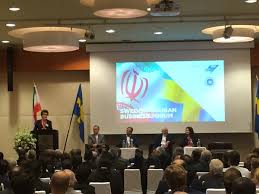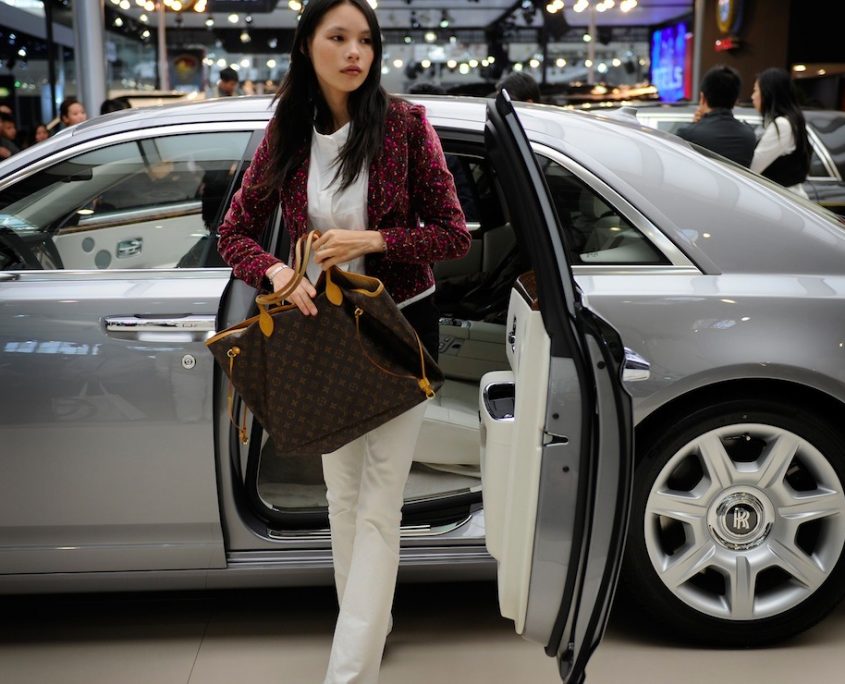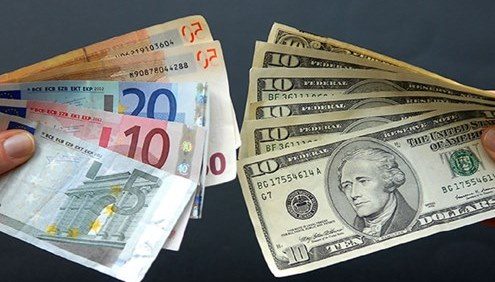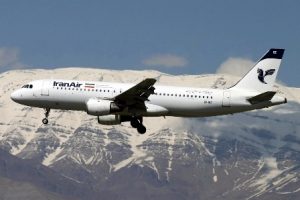Travelling with a 60-strong delegation of Iranian businessmen, Zarif also attended an Iran-Sweden mercantile conference in Stockholm.
Source : Tasnim News Agency
Swedish Embassy in Tehran opens a trade office as part of its efforts to boost business ties between the European country and Iran.
In a meeting with head of Tehran’s Chamber of Commerce, Swedish Ambassador Peter Tiller said the newly-established bureau is run jointly by the Swedish government and private sector.
Tehran and Stockholm eye rise in their economic relations after implementation of the Joint Comprehensive Plan of Action (JCPOA), a lasting nuclear deal between Iran and the Group 5+1.
Since June, Iranian Foreign Minister Mohammad Javad Zarif paid a visit to Sweden as part of a European tour, and arranged meetings with senior Swedish officials, within Prime Minister Stefan Lofven. In a meeting with the Scandinavian nations’ Minister for Enterprise and Innovation Mikael Damberg during the journey, Zarif considered ways to strengthen economic interaction in the post-sanctions era.
Travelling with a 60-strong delegation of Iranian businessmen, Zarif also attended an Iran-Sweden mercantile conference in Stockholm.
Source : Tasnim News Agency

According to a new World Wealth Report from Capgemini, Asian millionaires now control more wealth than their peers in Europe, North America and other regions. Of the 5.1 million Asian millionaires in 2015, 2.7 million came from Japan and 1 million were from China. China had the fastest growth last year, hitting 16.2 percent, and is expected to expand even further in coming years.
Asian millionaires saw their wealth jump by 9.9 percent in 2015, while poor performance in the equity markets in the United States and Canada slowed growth in North America to 2.3 percent last year, and Europe’s growth was steady, with a 4.8 percent increase led by Spain and the Netherlands, According to CNN.
Latin American millionaires, meanwhile, suffered a decline in net worth of 3.7 percent, driven by political volatility and a turbulent stock market in Brazil. Europe’s growth was steady, with a 4.8 percent increase led by Spain and the Netherlands.
Asians’ net worth has soared over the past several years. The total wealth of Asia’s richest residents totaled $17.4 trillion in 2015, up from $8.4 trillion in 2006. North America’s wealthy have $16.6 trillion socked away, up from $11.2 trillion in 2006.
Asia also surpassed North America in terms of the number of millionaires in 2014. And their ranks grew even more last year, soaring 9.4 percent.
Of the 5.1 million Asian millionaires in 2015, 2.7 million came from Japan and one million were from China. There were 4.5 million US millionaires.
China had the fastest growth last year, hitting 16.2 percent, and is expected to expand even further in coming years.
Wealth in Asia is driven mainly by the financial services, high tech and healthcare industries. And it’s coming more from those owning start-ups than from those running long-standing businesses.
“It’s a more entrepreneurial source of wealth,” said Bill Sullivan, head of global financial services market intelligence at Capgemini.
Wealth in Asia is driven mainly by the financial services, high tech and healthcare industries. And it’s coming more from those owning start-ups than from those running long-standing businesses.
“It’s a more entrepreneurial source of wealth,” said Bill Sullivan, head of global financial services market intelligence at Capgemini. Globally, the wealthy have seen their net worth explode in recent years, skyrocketing from $16.6 trillion in 1996 to $58.7 trillion in 2015. That surge has mainly been powered by the rise of manufacturing and economic activity in China. Capgemini expects worldwide wealth will surpass $100 trillion by 2025.

The withdrawal of many financial sanctions in Iran has reopened the county’s economy gates to a stream of new investments. Data from FDI Markets, that monitors cross-border greenfield investment, shows that prior to the lifting of sanctions, Iran was ranked 12th out of the 14 Middle East nations for FDI between January 2003 and December 2015, identifying a market share of 1.62 percent.
Since sanctions were removed this year, Iran has climbed to number three, with a market share of 11.11 percent, placed only behind regional powerhouses the United Arab Emirates and Saudi Arabia.
Sanctions removal will unfreeze billions of dollars of overseas assets and make oil to be sold internationally; a restriction that has charged Iran more than $160 bn in oil revenues since 2012. Despite holding the second largest gas and fourth largest crude oil reserves in the world, Iran has flagged behind other emerging Middle Eastern countries.
Global investment into Iran has been steadily growing since 2013, a year in which the country attracted just three FDI projects. This increased to eight in 2014 and nine in 2015.
It was in the first quarter of 2016, however, that the influence of sanction relief became evident. Iran won 22 FDI projects during the quarter, the highest rate of investment since FDI Markets began recording data in 2003.
Job creation and capital expenditure also rose between 2013 and 2016. Some 352 jobs were created in 2013 with capital expenditure of $79m, rising in 2014 to 2,732 new jobs and capital expenditure of $1.67 bn.
Although 2015 showed a 48 percent increase in capital expenditure overall, the first quarter was notable in failing to attract any FDI projects, in stark contrast to the same period this year.
Predictably, Tehran attracted 36 percent of recorded investments into the country during the first quarter of 2016, and 40 percent of all FDI into Iran since January 2013.
Since the sanctions were lifted the leading sector for investment into Iran has been financial services, which has attracted four investments from separate companies with capital expenditure of $60 m.
The country has also attracted investments from the automotive sector, business services, consumer electronics and textiles, among others.
The principal countries investing in Iran during the period were South Korea and Germany, which together committed to capital expenditure of $2.15bn.

South Korea-based steel producer Pohang Iron and Steel (Posco) has been the single largest investor in Iran this year, with plans to invest $1.6bn to build an integrated steel mill in the Chabahar Free Trade-Industrial Zone by March 2017. The company’s subsidiary Posco Energy also said it had entered a memorandum of understanding with Iran-based PKP to build a 500 megawatt off-gas power plant (using gas generated during steelmaking) nearby.
The upward trend recorded by FDI Markets suggests the economic rebound Iran is experiencing is set to continue. Nineteen investors signaled an interest in future investments in the country, representing an increase of 90 per cent from 2015.
The EU lifted most of its restrictions on IranAir as part of the latest changes to the bloc’s list of unsafe carriers.
Iran’s state airline, which has just achieved an agreement with Boeing Co to buy new jetliners, can resume flights in the EU, the European Commission said on Thursday, Reuters reported. IranAir could resume flights, some of the carrier’s aircraft would remain on the EU’s safety blacklist such as Boeing 747-200s, Boeing 747SPs and Fokker 100s, the commission said.
Iran’s state airline, which has just reached an agreement with Boeing Co to purchase new jetliners, can resume flights in the EU, the European Commission said on Thursday, Reuters reported.
Iran is dangling the prospect of significant business for Western planemakers as it emerges from decades of sanctions.While the European Commission, the EU’s executive, said IranAir could resume flights, some of the carrier’s aircraft would remain on the EU’s safety blacklist.
“I am happy to announce that we are now also able to allow most aircraft from IranAir back into European skies,” said EU Transport Commissioner Violeta Bulc. The Commission said the decision followed a visit to Iran by the EU executive in April.
Previously, only the carrier’s EU-manufactured Airbus planes could operate in the bloc, AFP added. The commission also removed Indonesian budget carrier Lion Air, a major buyer of Airbus and Boeing jets, from its safety blacklist. IranAir will be allowed to fly all of its planes in the EU except the Boeing 747-200s, Boeing 747SPs and Fokker 100s, the commission said. Iran needs an estimated 400 jets to renew its fleet and prepare for projected growth, according to Iranian and Western estimates. Iran has reached an agreement with Boeing for the supply of jetliners, reopening the country’s skies to new US aircraft for the first time in decades.
The Iranian flag carrier also agreed in January to buy 118 jets worth $27 billion from Airbus and is discussing further orders with Boeing. Iran’s aviation industry – among several other sectors – had been under a draconian regime of US-engineered sanctions for multiple years. The sanctions were lifted in January when a deal between Iran and the so-called P5+1 – the five permanent members of the Security Council plus Germany – came into effect.
The deal – the Joint Comprehensive Plan of Action (JCPOA) – envisaged steps by Iran to restrict certain aspects of its nuclear energy activities in return for the removal of sanctions against the country.

Iran’s Deputy Foreign Minister for American and European Affairs Majid Takht Ravanchi discussed Iran’s ties with Switzerland in a meeting with Swiss Foreign Minister Didier Burkhalter on Friday.
The two sides also exchanged views on regional developments as well as implementation of the Joint Comprehensive Plan of Action (JCPOA), IRNA reported.
Takht Ravanchi emphasized that the Swiss party should fully implement its commitments, especially in the banking sector.
Burkhalter also voiced Switzerland’s preparedness to boost relations with Iran and promote cooperation in the regional developments.
Political talks
The Iranian deputy foreign minister met Secretary of State at the Swiss Foreign Ministry Yves Rossier in Bern on Thursday for a round of Iran-Switzerland political talks, as part of a road map to the promotion of Tehran-Bern relations.
The negotiations involved three working groups discussing bilateral relations, regional developments and mutual cooperation in the judicial and human rights fields.
Aside from Takht Ravanchi and Rossier, senior experts from the two sides also held talks on the political and economic ties, regional issues, countering terrorism and fighting Islamophobia and the process of implementation of the JCPOA.
At the end of the talks, the interlocutors expressed satisfaction with the constructive talks and called for the continuation of such meetings to pave the way for the implementation of agreements between Iran and Switzerland.
Turkish Customs and Trade Minister Bulent Tufenkci says the country has serious plans to triple trade with Iran to $30 billion “as soon as possible”.
Tufenkci has told Reuters on Thursday that the January removal of sanctions against Iran has already prepared the grounds for Tehran and Ankara to boost the level of their mutual trade. according to presstv.ir.
“Banking and financial transactions have become easier (for Turkey) after the sanctions on Iran were softened, already boosting our business with Iran,” said Tufenkci.
Trade volume between Iran and Turkey rose to $21.9 billion in 2012, then fell below $10 billion in 2015 with the effects of the sanctions.
The Turkish and Iranian central banks have re-opened their connection on the SWIFT global transaction network, Reuters cited comments by an Iranian economy official in an interview earlier this month, in a sign of normalizing banking ties.
Turkish companies have used the January removal of anti-Iran sanctions as a major opportunity to resume trade and investment in the country, where other sectors of economy such as auto, clothing, textiles, machinery and chemicals as well as tourism, among others, have been beckoning to international investors.
Turkish industries have specifically recently increased their activities over their Iran investment plans.
Turkey’s Unit International in early June announced a $4.2 billion agreement with the Iranian Energy Ministry to build seven gas power plants in the country.
Also, Turkey has already announced that it plans to build at least 10 hotels in Iran in what officials in Ankara have already said will be a milestone in efforts to boost mutual economic ties with the Islamic Republic.
eTurboNews and Tehran Times interview with Mr. Ali Vaghefi , the managing director at Iran Doostan Tours Co. PJS.
Iran is a country of vast diversity, great natural beauty and numerous heritage sites from ancient times. Sitting on the Silk Road, the ancient connection gateway between west and east has resulted in creation of a unique culture with a combination of western and eastern values. Iran is home to a dozen cultures, traditions, ethnicities, and languages with a high potential in tourism attractions. Seeing the significant rise of tourists booking their trips for Iran even before the nuclear deal was signed is a proof of Iran’s popularity among the people who love traveling to the most exotic places in the world.
Ali Vaghefi an expert in Iran travel industry and the vice president and cofounder of Iranian Tour Operators Association believes the political decisions by President Hassan Rouhani which led into lifting sanctions of Iran brought the golden age in tourism industry for our country. With the new moderate policies the world has changed its view about Iran, and Iranian people have more support for their government as we saw a good contribution in the recent parliament election.
“Our friendly connection with the world will ease the ground for those who want to travel to Iran for its rich heritage sites or for business investments. Iran is one of the world’s biggest untapped tourist destinations having 19 UNESCO world heritage sites and fascinating natural attractions. Also since the country has been out of the international investment list, its market has a great potential for investors in many different fields such as hoteliers and aviation. Followed by arriving the new markets and companies to Iran the work force must receive the proper trainings which requires in bringing new technologies and educations to the country as well. All business investors and companies can obtain the most up to dated information about Iran’s economic situation and its future outlook from Iranian tour operator companies.” said Mr. Vaghefi.
Ali Vaghefi, as a successful business man in incoming tours to Iran since 1990, introduces new solutions for facing Iran’s infrastructural shortages in tourism industry. “Spring and fall season are the times that we have a rush in tourists arrival and for facing this upsurge Iran needs to upgrade its infrastructures as fast as possible. We need to triple the number of our four and five stars hotels which requires a lot of time. So the leading tour operators like us decided to create new products that will bring in use all the aspects of Iran’s unique attractions in winter and summer as well. Iran is privileged by sitting on a huge area that has resulted in a great variation of climate and biodiversity. In winter our travelers can drive to north of Tehran for skiing in international Shemshak ski resort or take a flight to south to the islands of Persian Gulf to enjoy jet skis or any other water activities. Also they have the option of going to safari tours in the desert and enjoy camel riding, off-roading, sand boarding, trekking in the desert, and star gazing at night.
For this purpose we built the first eco-friendly camp in Iran in 2012. Matinabad desert eco-camp and organic farm was established in Isfahan province and gained the award by UNDP as one of the 18 best practices in sustainable eco-tourism for following the CSR (Corporate Social Responsibility) and SRB (Socially Responsible Business) models.”
At the end Mr. Vaghefi said about the importance of media and its influence on Iran tourism industry. “Despite the warnings on travelling to Iran, all those who chose to experience this country have so many stories to tell about the warm and special welcomes they received form Iranian people. This is a world away of what the media says about Iran. We are privileged by having a powerful national protection that has made Iran the safest country in the region and our tourists feel absolutely secured during their stay. After the nuclear deal I have seen news agencies or magazines that had never talked about Iran before but are promoting Iran as one of the top destinations now. Iran became the number one destination on the National Geographic Traveler’s cool list of 2016, best places to travel in 2016 by Travel + Leisure, one of the top 16 destinations on CNN list, and many more.” Ali Vaghefi said he is so glad to see all the media who introduced Iran as an unsafe destination and tried to convince everyone to not travel to this country, have changed their view and have put Iran in their top destinations in 2016.